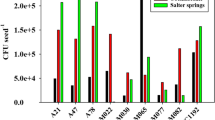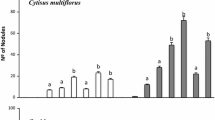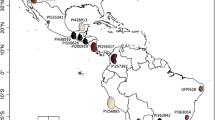Abstract
Studies were conducted to evaluate whether field-grown cultivars of alfalfa (Medicago sativa L.) nodulate differentially with members of a soil population ofRhizobium meliloti, and to determine the influence of the dominant nodule occupants on N2-dependent growth of the same cultivars under greenhouse conditions. Nodules were sampled from four replicate plots of ‘Vernal’, ‘Anchor’, and ‘Saranac’ alfalfa, and the isolates analysed serologically. Results from agglutination tests identified serogroup 31 as a dominant nodule occupant. A significant cultivar effect was observed, with a greater and more consistent occupancy rate by serogroup 31 across the replicates on Vernal (60%) compared to Anchor (24%) or Saranac (36%). The symbiotic effectiveness of the parent isolate of serogroup 31 was evaluated on each cultivar over four successive harvests in a greenhouse study. Significant cultivar x N source interactions for herbage dry weight resulted following the second harvest. Of the three cultivars, only inoculated Vernal responded with an increase in shoot dry weight and N2 assimilated relative to N supplemented plants between harvests two and three. In separate greenhouse experiments, field isolates of serogroup 31 from nodules on Vernal produced homogeneous, effective responses both on Vernal and Anchor. In contrast, serogroup 31 field isolates from Anchor nodules were highly heterogeneous in effectiveness on the parent host, with poorly effective isolates being substantially more effective on Vernal. The data indicate that attention should be given to the potential impact of the indigenousR. meliloti population upon cultivar ranking at specific field locations, and also to strain-cultivar idiosyncracies when carrying out physiological sutidies of regrowth characteristics.
Similar content being viewed by others
References
Barber L E 1980 Enumeration, effectiveness, and pH resistance ofRhizobium meliloti populations in Oregon soils. Soil Sci. Soc. Am. J. 44, 537–539.
Bottomley P J and Jenkins M B 1983 Some characteristics ofRhizobium meliloti isolates from alfalfa fields in Oregon. Soil Sci. Soc. Am. J. 47, 1153–1157.
Bromfield E S P, Sina I B and Wolynetz M S 1986 Influence of location, host cultivar, and inoculum on the composition of naturalized populations ofRhizobium meliloti inMedicago sativa nodules. Appl. Environ. Microbiol. 51, 1077–1084.
Burton J C and Wilson P W 1939 Host plant specificity amongMedicago sativa in association with root-nodule bacteria. Soil Sci. 47, 293–303.
Dughri M H and Bottomley P J 1983 Complementary methodologies to delineate the composition ofRhizobium trifolii populations in root nodules. Soil Sci. Soc. Am. J. 37, 939–945.
Eardly B D, Hannaway D B and Bottomley P J 1985 Nitrogen nutrition and yield of seedling alfalfa as affected by ammonium nitrate fertilization. Agron. J. 77, 57–62.
Erdman L W and Means U M 1953 Strain variation ofRhizobium meliloti on three variaties of lucerne (Medicago sativa L.) Agron. J. 45, 925–929.
Fishbeck K A and Phillips D A 1981 Combined nitrogen and vegetative regrowth of symbiotically-grown alfalfa. Agron. J. 73, 975–978.
Fuquay J I, Bottomley P J and Jenkins M B 1984 Complementary methods for the differentiation ofRhizobium meliloti isolates. Appl. Environ. Microbiol. 47, 663–669.
Gibson A H 1967 Carbon dioxide limitations of plant growth in tube culture, with special reference to legume-nodulation studies. Aust. J. Biol. Sci. 28, 837–842.
Hardarson G, Heichel G H, Barnes D K and Vance C P 1982 Rhizobial strain preference of alfalfa populations selected for characteristics associated with N2 fixation. Crop Sci. 22, 55–58.
Heichel G H, Barnes D K and Vance C P 1981 Nitrogen fixation of alfalfa in the seedling year. Crop Sci. 21, 330–335.
Heichel G H, Barnes D K, Vance C P and Henjum K I 1984 N2 fixation, and N and dry matter partitioning during a 4-year alfalfa stand. Crop Sci. 24, 811–815.
Heichel G H, Vance C P, Barnes D K and Henjum K I 1985 Dinitrogen fixation, and N dry matter distribution during 4 year stands of birdsfoot trefoil and red clover. Crop Sci. 25, 101–105.
Jansen van Rensburg H J and Strijdom B W 1982 Competitive abilities ofRhizobium meliloti strains considered to have potential as inoculants. Appl. Environ. Microbiol. 44, 98–106.
Jenkins M B and Bottomley P J 1984 Seasonal response of uninoculated alfalfa to N fertilizer: Soil N, nodule turnover, and symbiotic effectiveness ofRhizobium meliloti. Agron. J. 76, 959–963.
Jenkins M B and Bottomley P J 1985a Evidence for a strain ofRhizobium meliloti dominating the nodules of alfalfa. Soil Sci. Soc. Am. J. 49, 326–328.
Jenkins M B and Bottomley P J 1985b Composition and field distribution of the population ofRhizobium meliloti in root nodules of uninoculated field-grown alfalfa. Soil Biol. Biochem. 17, 173–179.
Kapulnik Y, Teuber L R and Phillips D A 1986 Seedling development as a component of increased yield in an improved alfalfa population. Crop Sci. 26, 770–775.
McGregor C, Mytton L R, Brockwell J and Gibson A H 1983 Nitrogen fixation by new and introduced lucerne cultivars. J. Aust. Inst. Agric. Sci. 49, 114–116.
Miller R W and Sirois J C 1982 Relative efficacy of different alfalfa cultivar-Rhizobium meliloti strain combinations for symbiotic nitrogen fixation. Appl. Environ. Microbiol. 43, 764–768.
Moore T C 1973 Research Experiences in Plant Physiology. Springer-Verlag, Berlin, 463p.
Mytton L R, Brockwell J and Gibson A H 1984 The potential for breeding an improved lucerne-Rhizobium symbiosis. 1. Assessment of genetic variation. Euphytica 33, 401–410.
Phillips D A, Cunningham S D, Bedmar E J, Sweeney T C and Teuber L R 1985 Nitrogen assimilation in an improved alfalfa population. Crop Sci. 25, 1011–1015.
Phillips D A, Teuber L R and Jue S S 1982 Variation among alfalfa genotypes for reduced nitrogen concentration. Crop Sci. 22, 606–610.
Tan G Y and Tan W K 1986 Interaction between alfalfa cultivars and Rhizobium strains for nitrogen fixation. Theor. Appl. Genet. 71, 724–729.
Teuber L R, Levin R P, Sweeney T C and Phillips D A 1984 Selection for N concentration and forage yield in alfalfa. Crop Sci. 24, 553–558.
Teuber L R and Phillips D A 1988 Influences of selection method and nitrogen environment on breeding alfalfa for increased forage yield and quality. Crop Sci. 28, 599–604.
Thurman N P and Bromfield E S P 1988 Effect of variation within and betweenMedicago- andMelilotus species on the composition and dynamics of indigenous populations ofRhizobium meliloti. Soil Biol. Biochem. 20, 31–38.
Viands D R, Barnes D K and Heichel G H 1981 Nitrogen fixation in alfalfa—responses to bidirectional selection for associated characteristics. USDA Tech. Bull. 1643.
Vincent J M 1970 A Manual for the Practical Study of the Root-Nodule Bacteria. I.B.P. Handbook No. 15. Blackwell Scientific Publishers, Oxford, 164p.
Author information
Authors and Affiliations
Additional information
Technical Paper No. 8716 of the Oregon State University Agricultural Experiment Station.
Rights and permissions
About this article
Cite this article
Busse, M.D., Bottomley, P.J. Nitrogen-fixing characteristics of alfalfa cultivars nodulated by representatives of an indigenousRhizobium meliloti serogroup. Plant Soil 117, 255–262 (1989). https://doi.org/10.1007/BF02220719
Received:
Revised:
Issue Date:
DOI: https://doi.org/10.1007/BF02220719




